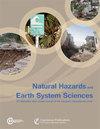Assessing Typhoon Soulik-induced morphodynamics over the Mokpo coastal region in South Korea based on a geospatial approach
IF 4.7
2区 地球科学
Q1 GEOSCIENCES, MULTIDISCIPLINARY
引用次数: 1
Abstract
Abstract. The inner shelf and coastal region of the Yellow Sea along the Korean Peninsula are frequently impacted by typhoons. The Mokpo coastal region in South Korea was significantly affected by Typhoon Soulik in 2018, the deadliest typhoon strike to the southwestern coast since Typhoon Maemi in 2003. Typhoon Soulik overran the region, causing extensive damage to the coast, shoreline, vegetation, and coastal geomorphology. Therefore, it is important to investigate its impact on the coastal ecology, landform, erosion/accretion, suspended-sediment concentration (SSC), and associated coastal changes along the Mokpo region. In this study, the net shoreline movement (NSM), normalized difference vegetation index (NDVI), fractional vegetation coverage (FVC), coastal-landform change model, normalized difference suspended-sediment index (NDSSI), and SSC–reflectance relation have been used to analyze the coastal morphodynamics over the typhoon periods. We used pre- and post-typhoon Sentinel-2 MultiSpectral Instrument (MSI) images for mapping and monitoring the typhoon effect and recovery status of the Mokpo coast through short- and medium-term coastal-change analysis. The findings highlighted the significant impacts of typhoons on coastal dynamics, wetland vegetation, and sediment resuspension along the Mokpo coast. It has been observed that typhoon-induced SSC influences shoreline and coastal morphology. The outcome of this research may provide databases to manage coastal environments and a long-term plan to restore valuable coastal habitats. In addition, the findings may be useful for post-typhoon emergency response, coastal planners, and administrators involved in the long-term development of human life.基于地理空间方法评估台风苏力在韩国木浦沿海地区引起的形态动力学
摘要朝鲜半岛沿岸的黄海内陆架和沿海地区经常受到台风的影响。2018年,韩国木浦沿海地区受到台风“苏利克”的严重影响,这是自2003年台风“玛米”以来对西南海岸最严重的台风袭击。台风“苏里克”袭击了该地区,对海岸、海岸线、植被和海岸地貌造成了广泛破坏。因此,研究其对Mokpo地区海岸生态、地貌、侵蚀/堆积、悬浮泥沙浓度(SSC)以及相关海岸变化的影响具有重要意义。本研究采用净海岸线运动(NSM)、归一化差异植被指数(NDVI)、植被覆盖率(FVC)、海岸地貌变化模型、归一化差异悬沙指数(NDSSI)和SSC–反射率关系来分析台风期间的海岸地貌动力学。我们使用台风前和台风后的Sentinel-2多光谱仪器(MSI)图像,通过中短期海岸变化分析,绘制和监测莫克波海岸的台风影响和恢复状况。研究结果强调了台风对莫克波海岸海岸的海岸动态、湿地植被和沉积物再补给的重大影响。据观察,台风引起的SSC影响海岸线和海岸形态。这项研究的结果可能为管理沿海环境提供数据库,并为恢复宝贵的沿海栖息地提供长期计划。此外,这些发现可能对台风后的应急响应、海岸规划者和参与人类生活长期发展的管理人员有用。
本文章由计算机程序翻译,如有差异,请以英文原文为准。
求助全文
约1分钟内获得全文
求助全文
来源期刊
CiteScore
7.60
自引率
6.50%
发文量
192
审稿时长
3.8 months
期刊介绍:
Natural Hazards and Earth System Sciences (NHESS) is an interdisciplinary and international journal dedicated to the public discussion and open-access publication of high-quality studies and original research on natural hazards and their consequences. Embracing a holistic Earth system science approach, NHESS serves a wide and diverse community of research scientists, practitioners, and decision makers concerned with detection of natural hazards, monitoring and modelling, vulnerability and risk assessment, and the design and implementation of mitigation and adaptation strategies, including economical, societal, and educational aspects.

 求助内容:
求助内容: 应助结果提醒方式:
应助结果提醒方式:


